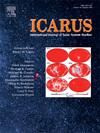A novel gravitational inversion method for small celestial bodies based on geodesyNets
IF 2.5
2区 物理与天体物理
Q2 ASTRONOMY & ASTROPHYSICS
引用次数: 0
Abstract
A comprehensive understanding of the internal structure of small celestial bodies is essential for elucidating their formation and evolutionary processes. However, the current observational techniques are severely limited in their ability to effectively probe the structure of small celestial bodies, thereby rendering the method of gravitational inversion the primary means of inferring internal structures. This study, grounded on the model architecture of geodesyNets, introduced a novel method that utilizes gravitational field data to infer the internal density distribution of small celestial bodies. Similar to geodesyNets, by leveraging principles of implicit neural representations (INRs), a deep neural networks (DNN) architecture based on self-supervised learning was developed. This proposed method involved meticulous optimization of hyperparameters, gravitational calculation strategy, activation functions, and loss functions tailored to the specific requirements of gravitational inversion for small celestial bodies. An inversion analysis was conducted on the CERES70E gravitational field model of the dwarf planet Ceres employing this method as a case study, revealing a two-layer internal structure. Moreover, gravitational inversion studies were conducted on simulated small bodies to evaluate the performance of various loss functions, activation functions, hyperparameters, and shape models on the precision of the inferred density fields. The results of these cases provided corroboration for the reliability of the inferred two-layer structural model for Ceres.
求助全文
约1分钟内获得全文
求助全文
来源期刊

Icarus
地学天文-天文与天体物理
CiteScore
6.30
自引率
18.80%
发文量
356
审稿时长
2-4 weeks
期刊介绍:
Icarus is devoted to the publication of original contributions in the field of Solar System studies. Manuscripts reporting the results of new research - observational, experimental, or theoretical - concerning the astronomy, geology, meteorology, physics, chemistry, biology, and other scientific aspects of our Solar System or extrasolar systems are welcome. The journal generally does not publish papers devoted exclusively to the Sun, the Earth, celestial mechanics, meteoritics, or astrophysics. Icarus does not publish papers that provide "improved" versions of Bode''s law, or other numerical relations, without a sound physical basis. Icarus does not publish meeting announcements or general notices. Reviews, historical papers, and manuscripts describing spacecraft instrumentation may be considered, but only with prior approval of the editor. An entire issue of the journal is occasionally devoted to a single subject, usually arising from a conference on the same topic. The language of publication is English. American or British usage is accepted, but not a mixture of these.
 求助内容:
求助内容: 应助结果提醒方式:
应助结果提醒方式:


